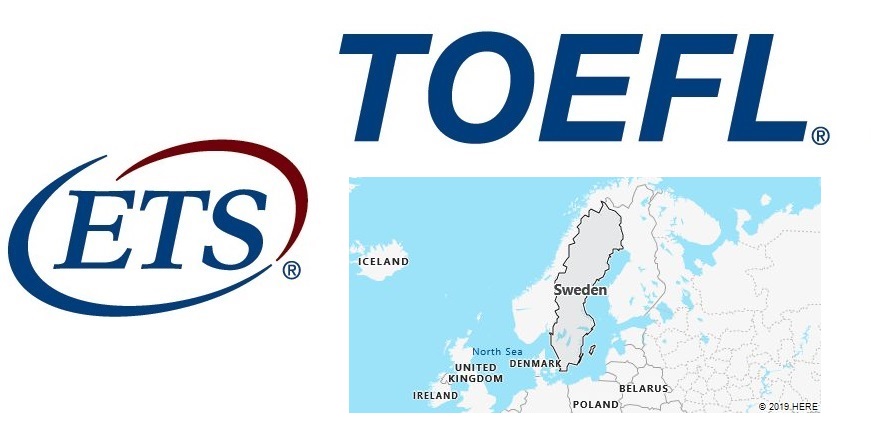The TOEFL iBT test is offered in this location.
The list below shows testing regions, fees and dates as of February 15, 2019, but availability may change when you register. Fees are shown in US$ and are subject to change without notice.
| Region | Testing Format | Fee | Test Dates |
|---|---|---|---|
| Malmö | TOEFL iBT | $270 $270 $270 $270 $270 $270 $270 $270 $270 |
Sat., Feb 16, 2019 Sat., Mar 09, 2019 Fri., Apr 05, 2019 Sat., Apr 13, 2019 Sat., May 04, 2019 Sat., May 11, 2019 Sat., Jun 01, 2019 Sat., Jun 15, 2019 Sat., Jul 13, 2019 |
| Stockholm | TOEFL iBT | $270 $270 $270 $270 $270 $270 $270 $270 $270 $270 |
Sat., Feb 16, 2019 Sat., Feb 23, 2019 Fri., Mar 08, 2019 Sat., Mar 09, 2019 Fri., Apr 05, 2019 Sat., Apr 13, 2019 Sat., May 04, 2019 Sat., Jun 01, 2019 Fri., Jul 12, 2019 Sat., Jul 13, 2019 |
Sweden Overview
Sweden is a parliamentary hereditary monarchy on the Scandinavian Peninsula with the capital Stockholm. From the Baltic coast in the south and east, the relief rises over a hilly country with extensive forests and numerous lakes to the high mountains of the Skanden. The climate of the largest, most populous and economically strongest country in Northern Europe is largely continental. Urban agglomerations are mainly found in the south of the country, which is sparsely populated compared to other European countries. The historical awareness is fed by the role of Sweden as a great power in the Baltic Sea (17th / 18th century) and a pioneer of parliamentarianism (19th century). The model of a comprehensive, tax-financed welfare state (“Volksheim”) with extensive redistribution shaped the political culture for decades. This also includes a high degree of transparency, both for authorities and for individual citizens (e.g. income, taxes). In terms of social policy, Sweden achieved a high level of equality between men and women. The enforcement of human and civil rights is given priority. The long practiced liberal migration policy was abandoned with the influx of refugees in 2015/16, also because the political consensus on it dwindled with the emergence of right-wing populist forces. In terms of foreign policy, the country is a pioneer in the dialogue with the global south and in climate protection. As a member of the EU, Sweden retained a certain degree of independence through its military non-alignment and the renouncement of joining the euro zone. The economy is strongly export-oriented, important industries are wood processing, vehicle and mechanical engineering as well as electrical engineering.
Country facts
- Official name: Kingdom of Sweden
- License plate: S.
- ISO-3166: SE, SWE (752)
- Internet domain:.se
- Currency: 1 Swedish krona (skr) = 100 ore
- Area: 447 420 km²
- Population (2018): 10.2 million
- Capital: Stockholm
- Official language (s): Swedish
- Form of government: Parliamentary monarchy
- Administrative division: 21 districts (Län)
- Head of State: King Karl XVI. Gustav
- Head of Government: Stefan Löfven
- Religion (s) (2017): Christians (60.2% Lutherans; 8.5% other), 31.3% non-denominational, Muslims
- Time zone: Central European Time
- National holiday: June 6th
Location and infrastructure
- Location (geographical): Northern Europe
- Location (coordinates): between 55 ° 20 ‘and 69 ° 04’ north latitude and 11 ° 58 ‘and 24 ° 10’ east longitude
- Climate: Winter damp and cold climate, in the south oceanic climate
- Highest mountain: Kebnekaise (2111 m)
- Road network (2016): 140 100 km
- Railway network (2016): 14 127 km
Population
- Annual population growth (2018): 0.8%
- Birth rate (2018): 12.1 per 1000 residents.
- Death rate (2018): 9.4 per 1000 residents.
- Average age (2018): 41.1 years
- Average life expectancy (2018): 82.2 years (women 84.3; men 80.3)
- Age structure (2018): 17.5% younger than 15 years, 20.4% older than 65 years
- Literacy rate (15 year olds and older): k. A.
- Mobile phone contracts (pre-paid and post-paid) (2017): 125 per 100 residents
- Internet users (2017): 96 per 100 residents
Economy
- GDP per capita (2017): US $ 52,925
- Total GDP (2017): US $ 536 billion
- GNI per capita (2018): US $ 55,070
- Education expenditure (2014): 7.7% of GDP
- Military expenditure (2017): 1% of GDP
- Unemployment rate (2017): 6.8%
Climate
As a result of the large north-south extension from the central European west wind zone to the polar climatic region, the climate shows strong differences. Overall, it is warmer than would be expected from the latitude. Due to the mountain wall, northern Sweden lies in the lee of the north Atlantic west wind drift and in the area of influence of the high pressure zones over inner Russia and therefore has a decidedly continental climate; the warm, dry summer allows temperatures of 30 ° C at the Arctic Circle. The long, snowy winters show absolute minima of −40 ° C in the north and between −20 ° C and −30 ° C in the south. The Gulf of Bothnia has been iced up for over five months. Ice-free harbors are only found in the south and west. Rainfall generally increases from east to west; in southern Sweden from around 500 mm (Baltic Sea) to over 1,000 mm (Kattegat), otherwise from around 500 mm (Baltic Sea) to over 2,000 mm (Skanden). 15% of the country’s area is north of the Arctic Circle (midnight sun; two months of winter darkness).
Vegetation
Southern Skåne and the west coast belong to the Central European deciduous forest region with beeches and oaks. The coniferous forests of the southern Swedish mountainous region are partly to be regarded as a branch of the northern European boreal coniferous forest. North of the central Swedish depression, which is still the location of oak, maple, ash, linden and others. Is deciduous trees, the boreal forest belt extends (with spruce, pine, birch). Large areas, especially in the north, are covered by raised bogs.

